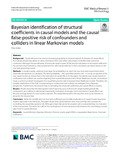Zitierlink:
http://dx.doi.org/10.25819/ubsi/10240Dateien zu dieser Ressource:
| Datei | Beschreibung | Größe | Format | |
|---|---|---|---|---|
| Kelter_Bayesian_identification.pdf | 1.39 MB | Adobe PDF |  Öffnen/Anzeigen |
| Dokumentart: | Article | Titel: | Bayesian identification of structural coefficients in causal models and the causal false-positive risk of confounders and colliders in linear Markovian models | AutorInn(en): | Kelter, Riko |
Institut: | Department Mathematik | Schlagwörter: | Causal inference, Bayesian inference, Directed acyclic graph (DAG), d-separation, Bayes factor, Structural coefficients | DDC-Sachgruppe: | 510 Mathematik | GHBS-Notation: | TKM | Erscheinungsjahr: | 2022 | Publikationsjahr: | 2023 | Auch erschienen: | BMC medical research methodology ; 22, article number 58. - https://doi.org/10.1186/s12874-021-01473-w | Zusammenfassung: | Background: Causal inference has seen an increasing popularity in medical research. Estimation of causal effects from observational data allows to draw conclusions from data when randomized controlled trials cannot be conducted. Although the identification of structural causal models (SCM) and the calculation of structural coefficients has received much attention, a key requirement for valid causal inference is that conclusions are drawn based on the true data-generating model. Methods: It remains widely unknown how large the probability is to reject the true structural causal model when observational data from it is sampled. The latter probability – the causal false-positive risk – is crucial, as rejection of the true causal model can induce bias in the estimation of causal effects. In this paper, the widely used causal models of confounders and colliders are studied regarding their causal false-positive risk in linear Markovianmodels. A simulation study is carried out which investigates the causal false-positive risk in Gaussian linear Markovian models. Therefore, the testable implications of the DAG corresponding to confounders and colliders are analyzed from a Bayesian perspective. Furthermore, the induced bias in estimating the structural coefficients and causal effects is studied. Results: Results show that the false-positive risk of rejecting a true SCM of even simple building blocks like confounders and colliders is substantial. Importantly, estimation of average, direct and indirect causal effects can become strongly biased if a true model is rejected. The causal false-positive risk may thus serve as an indicator or proxy for the induced bias. Conclusion: While the identification of structural coefficients and testable implications of causal models have been studied rigorously in the literature, this paper shows that causal inference also must develop new concepts for controlling the causal false-positive risk. Although a high risk cannot be equated with a substantial bias, it is indicative of the induced bias. The latter fact calls for the development of more advanced risk measures for committing a causal type I error in causal inference. |
Beschreibung: | Finanziert im Rahmen der DEAL-Verträge durch die Universitätsbibliothek Siegen |
DOI: | http://dx.doi.org/10.25819/ubsi/10240 | URN: | urn:nbn:de:hbz:467-24348 | URI: | https://dspace.ub.uni-siegen.de/handle/ubsi/2434 |
| Enthalten in den Sammlungen: | Geförderte Open-Access-Publikationen |
Diese Ressource ist urheberrechtlich geschützt. |
Seitenansichten
354
checked on 03.04.2025
Download(s)
52
checked on 03.04.2025
Google ScholarTM
Prüfe
Prüfe
Alle Ressourcen in diesem Repository sind urheberrechtlich geschützt, soweit nicht anderweitig angezeigt.

